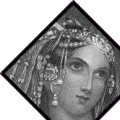





This site brings together materials for reading Dickinson's poem "He touched me" within the context of the popular oriental poem Lalla Rookh by Thomas Moore, and within the context of orientalism in the
U.S. more generally.
The introduction below begins with definitions of orientalism in the Webster dictionary the Dickinson's owned and in
the latest edition of the OED. Then it offers a brief summary of Edward Said's seminal work on the rise of oriental studies in the nineteenth century. This is followed by a couple of paragraphs on orientalism in
the U.S. and information on Lalla Rookh. Finally, the introduction provides information about Dickinson's knowledge of eastern lore and politics and the circulation of Lalla Rookh among Dickinson family members.
![]()
An American Dictionary of the English Language, by Noah Webster, 1855:
Orient, n.: The east
Oriental, adj.: Eastern, situated in the east; particularly, in or about Asia
Oriental, n.: A native or inhabitant of some eastern part of the world. We give the appellation to the inhabitants of Asia, from the Hellespont and Mediterranean to Japan.
Orientalism, n. A term applied to doctrines or idioms of the Asiatic nations.
Oxford English Dictionary 1989
Orientalism
a. Oriental character, style, or quality; the characteristics, modes of thought or expression, fashions, etc. of Eastern nations
b. Oriental scholarship; knowledge of Eastern languages
![]()
ORIENTALISM
Although the 1855 Webster does not include "Oriental scholarship" as one of
its definitions of Orientalism, academic study of the East burgeoned in the
nineteenth century. Indeed, beginning in the first decades of the nineteenth
century, the East became a popular topic, especially in England, and Western
authors wrote travel literature, economic treatises, histories of religion,
poems, and novels about the East.
Critical thinking about the assumptions implicit in this body of
nineteenth-century writing about the East by Westerners began in earnest in
1979 with Edward Said's Orientalism. The popularity of Eastern themes had
long been noted, but Said sought to identify patterns in how Westerners
figured the East and to assay the political significance of orientalist
discourse. According to Said, Orientalism is ultimately "a political
doctrine willed over the Orient" by Occidentals (204). As he reminds us, the
"Orient is not only adjacent to Europe; it is also the place of Europe's
greatest and richest and oldest colonies, the source of its civilizations
and languages, its cultural contestant, and one of its deepest and most
recurring images of the Other." In short, "the Orient has helped to define
Europe (or the West) as its contrasting image, idea, personality,
experience" (1).
Nineteenth-century orientalist discourse turned the East into a subject that
could be known by the West and by so doing it disguised the West's specific,
political interests in eastern lands and people. (In a discussion of
"empiricist foundationalism," Judith Butler explains: "insofar as power
operates successfully by constituting an object domain, a field of
intelligibility, as a taken-for-granted ontology, its material effects are
taken as material data or primary givens." This is a fundamental move of
nineteenth-century race science and also nineteenth-century orientalist
discourse.) Once posited, the East became a fact. As Said points out, the
Orient became "an almost unconscious (and certainly untouchable) positivity"
(206). Or, as Michael Dalby suggests, "the Orient subsists in fact only as a
structural relationship in contrast to Us’ (488).
Although Western writers might invoke the Orient in order to figure a wide
variety of ideas, in general, nineteenth-century Western images of the
Orient foreground sexuality and politics. Eastern lands are places of exotic
and sexually available women, effeminate men, and political intrigue. The
Orient is seen as radically different from "us" and thus was often used to
posit a unified West. The Orient was typically figured as eccentric,
backward, silently different, sensual, and passive. For many writers the
East had a tendency towards despotism and away from progress, and it
represented not only the Other but also a conquerable and inferior Other. ORIENTALISM IN THE U.S. Significantly, Said begins his study by exempting
the United States from his commentary: "Unlike the Americans, the
French and British--less so the Germans, Russians, Spanish, Portugese,
Italians, and Swiss--have had a long tradition of what I shall be calling
Orientalism, a way of coming to terms with the Orient that is based on
the Orient's special place in European Western Experience" (1).
Indeed, the U.S. was not involved in colonizing the east in the nineteenth
century, as were the English and the French. Between 1790 and 1830, more
than one hundred and fifty million people primarily in the East were brought
under British imperial rule. During these same years, the U.S. had little
direct engagement with the east. Nevertheless, by the middle of the nineteenth
century, the lore of the Orient had reached the U.S. and the east was
a popular topic for many writers. Whittier evoked the east in his poems,
collected English translations of moral sayings from Hindu classics in
his "Oriental Maxims," and owned many works about the Orient,
including W. R. Alger's Poetry of the Orient and R. H. Stoddard's
The Book of the East. Both Emerson and Whittier read extensively
in the Bhagavadgita, and Lydia Maria Childs's history, The Progress
of Religious Ideas, which gives Eastern religions ample and
respectful treatment (Christy). LALLA ROOKH One of the most popular oriental poems, both
in England and in the U.S., was Thomas Moore’s 1817 book-length poem Lalla
Rookh. Orientalism was not only popular by the early 1800s, it was
also profitable. A few years before Moore wrote Lalla Rookh, Byron
encouraged him to write about the Orient: "Stick to the East
. . . The North, South, and West, have all been exhausted. . . the public
are orientalizing . . . ". Bryon's EasternTales
(1813?) was immensely popular, and his publisher noted this
success and subsequently commissioned Moore's Lalla Rookh for an unprecedented
three thousand guineas (Leaske). Moore's poem offers a complex oriental tale
in which desire and politics are woven together. The frame tale tells
of a princess’s trip from Delhi to Cashmere to meet her betrothed. Along
the way a poet, Lalla's husband-to-be in disguise, recounts to her historical
tales of insurrection and ecstasy, of revolutionary heroes and passionate
women. Moore’s book was popular in the U.S. (it became a standard against
which other orientalist narratives—fictional and historic—were judged),
and the edition in the Dickenson household was lavishly illustrated by
some of the best-known illustrators of the day [link to images page].
Significantly, the illustrations, much like Moore's poem, use the east to
invoke worlds and to write of lives not sanctioned in the west. The
illustrations in particular eschew dainty femininity ensconced in private
spaces for images of a sumptuous female sexuality in a world of political
action. DICKINSON and the ORIENT The Dickinson family was attentive to political news and literary treatments of the east:
1. Susan Dickinson and Emily named a drafty hallway where they often met the
"Northwest passage" in honor of Sir John Franklin's failed efforts
to discover a Northwest passage to the Orient (see Patterson 91).
2. Dickinson wrote a short note to Susan in 1882 that refers to both a Longfellow
poem that mentions Arab tents and to the recent British invasion of Egypt --"Love and Conquest"
3. Susan owned an 1860 anthology that included selections from Lalla Rookh.
The copy of the complete poem in the Dickinson household has three passages
marked. One scholar suggests that these passages about the pleasures,
pangs, and disillusionments of love are marked in a manner typical of
Emily Dickinson, while another scholar notes that many books were shared
between the two households and that markings commonly taken to be Emily's
might well be Susan's.
4. Susan also makes a reference to Lalla Rookh
as a book one might have on the bedstand in an essay she drafted on domestic
help (see http://jefferson.village.virginia.edu/dickinson/susan/domestic1.html)
Critical Issues | Student Projects | Bibliography



